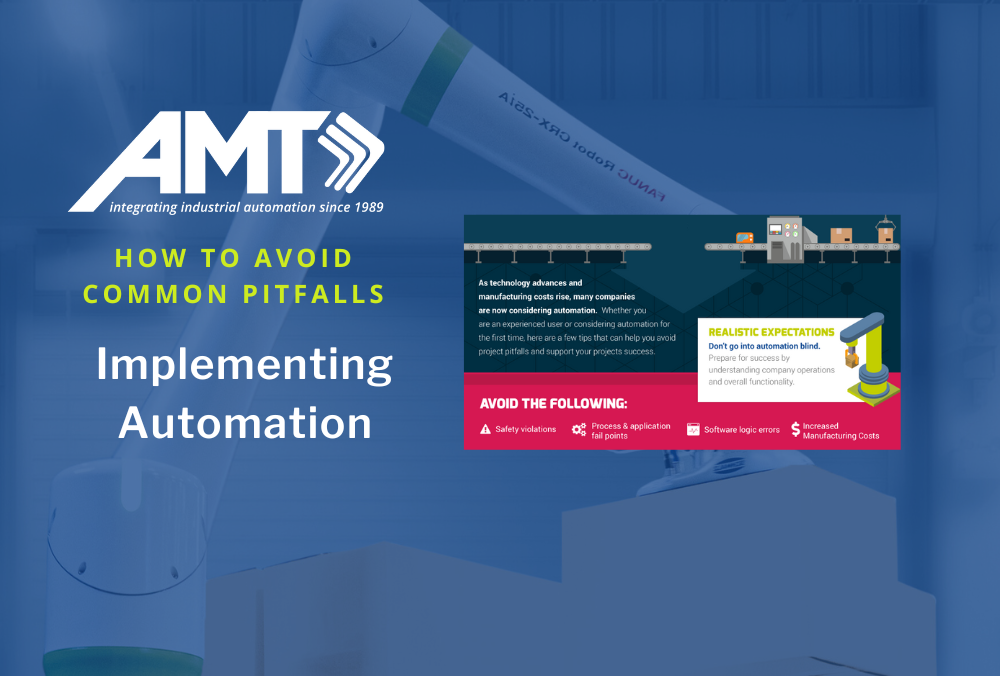Avoiding Common Pitfalls When Implementing Automation
Change is happening. Market requirements, customer expectations, and business processes are digitizing rapidly, and your facility needs to keep up. But how do you make a digital shift in your manufacturing company? What are the steps you should take? How can digitalization positively impact your company?
The digital transformation in your facility might seem daunting – but the impacts are beneficial to you, your employees, and your company. Taking the appropriate steps to implement digitization is crucial: working from the top down, making sure that your company’s philosophy is aligned with digitalization and your company is transparent in its decision making. Find solutions that work with your infrastructure, and make sure that your employees are retrained on new processes.
Of course, preparing for and implementing a digital transformation can be difficult. AMT is here to help when you’re ready to get started. Through consultation, engineering, and assessments, we’ll be with you and your company every step of the way.
Check out the infographic below to gain a better understanding of the impact digital transformation can have on your facility.

As technology advances and manufacturing costs rise, many companies are now considering automation. Whether you are an experienced user or considering automation for the first time, here are a few tips that can help you avoid project pitfalls and support your project's success.
Set realistic expectations. Don’t go into automation blind. Prepare for success by understanding company operations and overall functionality.
Avoid the following:
- Safety violations
- Process & application fail points
- Software logic errors
- Increased manufacturing costs
By performing the following:
Evaluate automation benefits:
- Increase throughput and efficiency
- Optimize safety and quality
- Reduce manufacturing footprint
- Decrease labor and production costs
Gather data based on these metrics:
- Desired manufacturing improvements
- Discrete tasks required to manufacture
- Return on investment
- Overall impact on company culture
Analyze system attributes:
- Scalability
- Flexibility
- Facility changes
- Manufacturing risk
- Technology risk
- Compatibility
- Packing materials design change
- Material flow
- Recurring schedule and costs
- Product requalification
- Waste by-product and material disposal
Process Comprehension
A practical next step is to break down your current process and compare to your perceived “ideal” process.
Walk the manufacturing floor and perform a task-by-task breakdown of your process that includes products, people, and data impact to key manufacturing inputs and outputs. Then, compare them to your ideal process and desired deliverables of an improved system.
Use multiple tools:
- Process flow charts (inputs/outputs)
- Value stream mapping (VA/NVA/waste)
- Spaghetti (nonlinear tracing)
While taking notes about your operation, keep track of:
- The number of:
- Final assemblies
- Subcomponents per final assembly
- Processes per final assembly
- Operators
- Types of equipment
- Cycle time
- Baseline of current system
- Current quality numbers (Cpk, Ppk, scrap, rework)
- Footprint
Appropriate Partner Selection
Your last step is to find an integrator that has your best interest in mind, works alongside you, leads when expected, and always lets the facts speak for themselves.
Qualifying criteria:
- Trust
- Business stability
- Proposal
- Application experiences
- Engineering capabilities
- Program management
- Service and technical support
- Spare parts
- Safety
- Training

